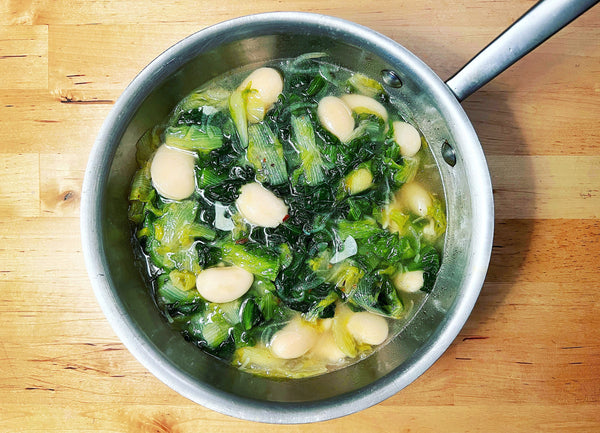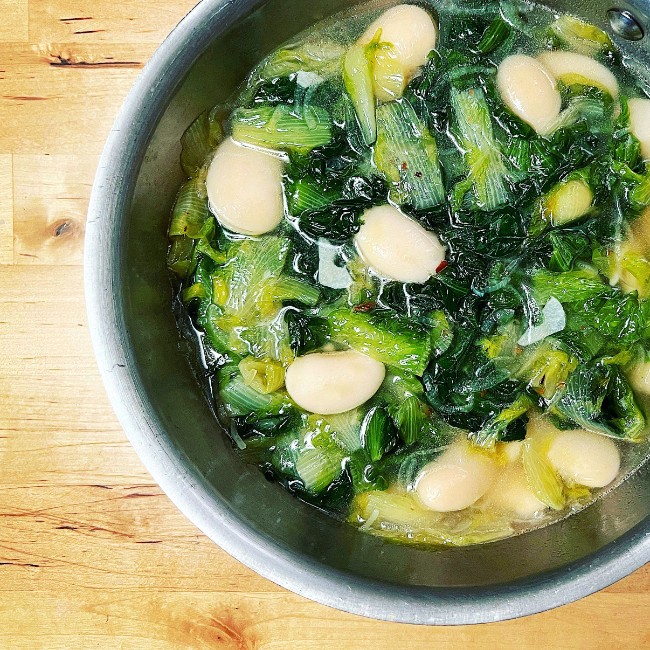
Scarola e Fagioli (Escarole & Beans)
A classic Tuscan cucina povera (aka broke eats) dish. This hearty, energizing, and healthy dish is one of my winter go-tos when there isn't much in the way of fresh produce. I take a few liberties like using chicken stock and Spanish Judion beans to make it more of a meal, check the variations for a more traditional version as well.
A classic Tuscan cucina povera (aka broke eats) dish. This hearty, energizing, and healthy dish is one of my winter go-tos when there isn't much in the way of fresh produce. I take a few liberties like using chicken stock and Spanish beans to make it more of a meal, check the variations for a more traditional version as well.

Ingredients
1 head of escarole, about 1 1/2 pounds*
-
1/3 cup olive oil
1 small onion, peeled and thinly sliced
1-2 cloves of garlic, peeled and thinly sliced°
-
1/2 tsp peperoncini
1 cup of cooked Judión beans, with their cooking liquid, or cannellini (see instructions in the notes)†
Low-sodium chicken stock‡
-
Salt, as needed
Directions
Prepare a large pot of boiling salted water. Alternative directions are below in the notes if you prefer not to blanch.*
In a small pot, add the olive oil and onions and cook on low heat, stirring occasionally, until translucent and softened (about 6-8 minutes).
Meanwhile blanch the escarole. Holding the bundle with one hand, slice off the bottom root-end with a sharp knife and discard, then slice off about 2 inches of the thickest portion of the leaves and add to the pot, stir and wait 30 seconds, then add the next two inches, and so on. Once the last addition has cooked remove all the leaves with a strainer, rinse briefly to cool, and squeeze them by hand to remove some of the water.
Add the garlic, escarole, and peperoncini to the pot and cook for another 2-3 minutes, until everything is well coated.
Add the beans, then add chicken stock until everything is submerged. Heat through until the beans are warm, taste and adjust seasoning with salt, and serve.
Recipe Note
Recipe Notes
* Escarole will often be by the lettuces, and looks suspiciously like romaine. If you can not find it you can substitute friseé, or spinach, or arugula (just not the young and tender versions which are more suited for salad).
If you'd prefer not to blanch, you can cook the leaves in a covered skillet with minimal water, just make sure to take the leaves off the core first and thoroughly wash them to remove any dirt. Then squeeze and chop them roughly. Blanching has the advantage of having any dirt settle to the bottom of the pot which is why I do it that way.
° This time of year a fair bit of garlic tends to be on the older side (it's a summer vegetable). I remove any green shoots if I find them as they are bitter and unbalanced in flavor.
† Judión beans are grown in Spain and have incredible flavor and a delicate creamy texture. They are my favorite bean to use in almost any dish that calls for white beans, and easily turn something simple into much more of a meal. If you have a Spanish market near you they should stock them also.
‡ I often just thin chicken stock with water and add a couple teaspoons of gelatin for body, it's an easy hack that I've been doing for many years. Just don't waste money on those little packets and get a big bag instead if you do this often.
Variations & Ideas
Flavor Boost
- A bit of miso or taberu rayu is always great. I like adding a bit of fresh lemon as well in this case for balance.
• This dish is traditionally done with water (chicken is expensive), and cannellini beans. If you want to try this version (which is vegan), rinse the beans before adding them (I've yet to find inexpensive canned cannellini beans with a great tasting liquid), and add a small handful of minced oil-cured black olives for salt and body.
• Both dishes are great with bread. Try slices of toasted sourdough, or whip up an easy focaccia.
• For a veggie dinner if I don't feel like having bread, I like serving this with my Winter Bean Salad, plus a couple of steamed artichokes (which you can surprisingly find this time of year now that there is production in Mexico).
Questions? Contact helen@laboiteny.com


